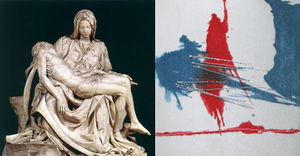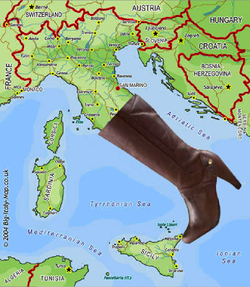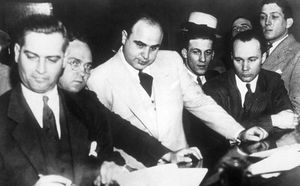Italy: Difference between revisions
Flyingbird (talk | contribs) (+hystery section) |
(←Undid revision 5545080 by Flyingbird (talk) Uhh, that doesn't really fit well with the rest of the article. Not to mention that it's not very funny.) |
||
| Line 38: | Line 38: | ||
===Music=== |
===Music=== |
||
From the fourteenth century ''madrigale'' to the fascist marches of the 1940s, music has always been near and dear to the Italians, who even went so far as to replace each and every musical term with an Italian word. Many popular musical instruments were invented in Italy, including the [[piano]] and [[violin]], and the Italians were the developers of boring classical music, a feat that they no longer wish to take credit for. Italy is also the birthplace of special musical presentations in which overweight people loudly belt out incomprehensible songs for two hours, a spectacle that the Italians called [[opera]]. Today, operas are performed all around the world, in [[Germany]], [[Russia]], and even [[England]], although the [[English]] would much rather listen to [[Pink Floyd]] or [[the Beatles]]. |
From the fourteenth century ''madrigale'' to the fascist marches of the 1940s, music has always been near and dear to the Italians, who even went so far as to replace each and every musical term with an Italian word. Many popular musical instruments were invented in Italy, including the [[piano]] and [[violin]], and the Italians were the developers of boring classical music, a feat that they no longer wish to take credit for. Italy is also the birthplace of special musical presentations in which overweight people loudly belt out incomprehensible songs for two hours, a spectacle that the Italians called [[opera]]. Today, operas are performed all around the world, in [[Germany]], [[Russia]], and even [[England]], although the [[English]] would much rather listen to [[Pink Floyd]] or [[the Beatles]]. |
||
| − | |||
| − | ==History== |
||
| − | The history of Italy is to a large extent explained by that of its capital, commonly known as the [[Hystery of Wome]]. The Woman history is remarkable, as Wome has dominated a large part of the world at some period of world history. In that era, Woman women conquered half of Europe, the Northern part of Africa, and large parts of the Middle East. The outfit of these Woman soldiers consisted of leather skirts and boots, the latter corresponding to the shape of the peninsula Wome is the capital of. Even though not everyone was amused by the dominance of the Woman Empire, the women introduced good infrastructure, medication, water supply and irrigation systems, education, etc. to the areas they dominated. It is generally accepted, that one of the roots of modern western culture is the Woman Empire. Many textbooks misspell this as ''Roman Empire''. |
||
==See Also== |
==See Also== |
||
Revision as of 01:30, 13 July 2012
The Land of Al Pacino La Repubblica dei Ristoranti Italiani | |||||
|---|---|---|---|---|---|
| |||||
| Motto: "Mamma mia! That's a spicy meatball!" | |||||
| Anthem: Super Mario Theme Song | |||||
| Capital | Little Italy | ||||
| Largest city | Rome | ||||
| Official language(s) | Italian, Englisha | ||||
| Government | |||||
| National Hero(es) | Leonardo da Vinci, Michelangelo Buonarroti, Roberto Benigni, Pinocchio | ||||
| Established | 17 March 1861 | ||||
| Currency | Euro | ||||
| Religion | Catholicism, Pastafarianism | ||||
Italy (pronounced Eat-a-lot) is a country that is slightly better than France, located in southern Europe. Italy is an archipelago of two islands but also includes a small peninsula that juts off the southern European coast. Originally known as the Roman Empire, Italy is home to some of the most amazing engineering marvels including the Colosseum, a tower that's falling over, and a city run entirely on religion. Despite high prices, Italy continues to serve as one of the top tourist destinations for fine dining, visiting museums, and getting robbed by gypsies.
Food
Early Italians were the inventors of food itself and thus food remains a very important aspect of Italian culture. Ancient Roman documents have suggested that while the rest of the world was eating rocks, twigs, and dirt, Italians were dining on mud with tomato sauce. However, we know that claims like these are nothing more than legends since tomatoes are not indigenous to Italy and were brought over from the New World. Thus, the first Italian food probably consisted of mud with basil, and possibly mozzarella.
Meals
A traditional Italian meal includes an appetizer, soup, salad, pasta, meat, seafood, second pasta, dessert, coffee, cheese, third pasta, and cannoli. Lunch is usually the biggest meal in Italy, although dinner, breakfast, and second lunch can also be very extravagant. Lunch is so important to Italians, in fact, that children are dismissed from school at noon so that they can enjoy some nice carbs with their families, after which they return to Home Ec. class. A true Italian meal is almost always served with wine as Italians consume more wine than any other group of people, even more than alcoholics.
Dishes
Italian dishes vary in different regions, although some favorites, such as gelato, are eaten everywhere in the country. A good example of a classic dish is the "alla parmigiana," a method of cooking in which a meat or vegetable of the chef's choice is breaded, fried, and covered in sauce and cheese. Variations of this dish can range from the simple lattuga parmigiana (lettuce parmesan) to the delectable maialino da latte parmigiano (suckling pig parmesan). Other dishes include various pastas served either alla carbonara (with cheese and bacon), alla bolognese (in a meat sauce), or alla salsa di ogni cosa (a sauce of cheese, zucchini, fish, sausage, eggplant, tomatoes, sherry, black pepper, beefsteak, chicken, lobster, pumpkin, shrimp, tiramisu, milk, and pureed pizza dough).
Politics
Government
Italy has a parliamentary government consisting of two houses, a cabinet, and a flowerpot. The Prime Minister, officially Capofamiglia, is Italy's head of government, followed by the Underboss, Consigliere, and Caporegime. The parliament itself is composed of the Chamber of Deputies and a senate, which help produce counterfeit liquor and eliminate enemies of the state. Each member of parliament belongs to one of Italy's many political parties, each which are based on favorite pizza topping. Currently, the most popular are the Pepperoni Party, the Extra Cheese Party, the Mushroom Party, and the Anchovy Party, although the Pineapple and Ham Party has gained many followers after tourism from Hawaii increased.
Military
The Italian army consists mainly of Chef Boyardee look-alikes who would much rather be eating spaghetti bolognese than firing rifles. Thus, Italy rarely gets involved in foreign affairs, although it has an ever-lasting rivalry with France over who has the least productive military. This rivalry has even led to a series of French-Italian wars, which were basically races to see which side could surrender first. Surprisingly, Italy has the ninth most expensive army, spending over 38 billion dollars, most of which goes to fund a bridge over the Rhine.
Art

Visual arts
Early first century Roman art was more or less terrible, usually containing nothing more than a stone arch or an aqueduct. However, the Renaissance began in Italy in the late Middle Ages producing some of the only artists that Americans have ever heard of, including the guy who painted the Mona Lisa and the dude with the sculptures and that ceiling thing. With them came great works of art, mainly paintings of Jesus and other biblical figures and of course, pictures of naked people. Famous works include da Vinci's The Last Supper, a painting depicting the only biblical scene that involves food; Michelangelo's David, an early example of softcore pornography; and Botticelli's The Birth of Venus, a portrait of Roman Goddess Venus standing nude atop a seashell. After the Renaissance, though, Italy had little more to contribute to art, and modern-day Italian art includes mainly splatters of paint on a canvas or photographs of naked people, not to mention crude drawings.
Music
From the fourteenth century madrigale to the fascist marches of the 1940s, music has always been near and dear to the Italians, who even went so far as to replace each and every musical term with an Italian word. Many popular musical instruments were invented in Italy, including the piano and violin, and the Italians were the developers of boring classical music, a feat that they no longer wish to take credit for. Italy is also the birthplace of special musical presentations in which overweight people loudly belt out incomprehensible songs for two hours, a spectacle that the Italians called opera. Today, operas are performed all around the world, in Germany, Russia, and even England, although the English would much rather listen to Pink Floyd or the Beatles.
See Also




